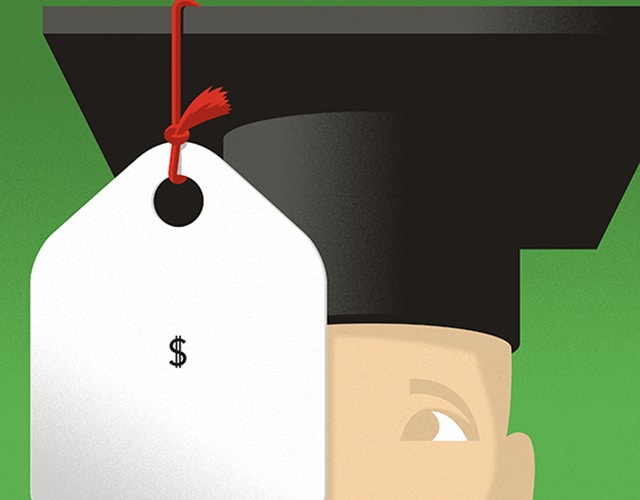Families with college-bound students may well have shuddered when they heard that the official, full cost of a year at some four-year private schools will soon hit six figures.
But outrage over mushrooming college “sticker” prices clouds a reality that some families may not fully understand: Few students pay the full price. That’s because colleges give financial aid to income-eligible students and merit aid — in the form of scholarships or tuition discounts — to more affluent families that may be able to pay the full price but may balk at doing so.
On average, private nonprofit colleges cut tuition by more than half for first-time undergraduates, according to a recent report from the National Association of College and University Business Officers.
That means college sticker prices — the full “cost of attendance” that the federal government requires colleges to publish — are an increasingly unreliable indicator of what a family will pay, according to a report titled, in part, “Ignore the Sticker Price,” and published Friday by the Brookings Institution, a Washington think tank. That goes for both low- and middle-income families, as well as for higher-income families that don’t qualify for need-based aid.
“Our current system of setting and communicating college prices simply does not work,” wrote the author of the report, Phillip Levine, an economics professor at Wellesley College and a nonresident senior fellow at Brookings. He analyzed federal data to track changes in college pricing for students at different income levels.
“We cannot expect students to make sound decisions regarding educational investments if they do not understand how much college will actually cost them,” he added.
Sticker prices are easier to track than net prices — what students end up paying after deducting grants and other financial aid that doesn’t have to be repaid — but misleading because the share of students paying them has declined over time, the report said. In the 2019-20 school year, about 16% of students at private, nonprofit four-year colleges paid the full sticker price, down from 29% in the 1995-96 school year. (At in-state public colleges, about a quarter paid the sticker price in 2019-20, down from about half in 1995-96.)
Why would colleges promote themselves as more expensive than they really are? Colleges increasingly compete for students, and they may use the sticker price as a marketing tool to “signal” that the school is high quality, Levine said. They then award merit aid to encourage admitted students to enroll.
Average sticker prices at both private and public colleges rose roughly 70% from the 1995-96 to 2019-20 school years. Over the same period, typical net prices for lower-income students (with family incomes below $50,000) rose 44% at public schools and 24% at private schools — substantial increases but far below the rise in sticker prices.
For more than a decade, the report found, the typical net price at private colleges has increased just for higher-income students. But that still doesn’t mean college is affordable for low- or moderate-income families. Students from families with incomes of less than $50,000 are still being asked to pay almost $25,000 to attend a typical private institution, the report found.
“You do not need a Ph.D. to recognize that is not affordable,” Levine said in an interview.
The net price at public colleges has also become more of a stretch for lower-income families. At public colleges, the typical net price that low-income students pay, adjusted for inflation, rose to $18,000 in 2019-20, from $12,500 in 1995-96.
The gap between public price tags and actual cost deters less affluent students, who don’t even apply once they see an eye-popping list price.
“Sticker shock is a really big issue,” particularly for lower-income, Black and Hispanic students, said James Dean Ward, principal for policy and economic research at Ithaka S+R, a nonprofit research and advisory group focused in part on higher education.
Some colleges are “resetting” tuition to more accurately reflect what students will pay, hoping to attract more applicants. Bridgewater College, a small liberal arts school in rural Virginia, announced last year that it was lowering its published tuition more than 60%, to $15,000 from $40,300, starting next fall. (Housing, meals, books, supplies, travel and personal expenses, which add substantially to the cost, are extra.)
“I think it’s time for higher education to be more transparent,” said David Bushman, Bridgewater’s president, adding that the move was made in part to answer growing public skepticism about the value of a college degree. Virtually no students were paying the school’s full cost of attendance in recent years, according to Bridgewater’s statistical report. The school’s new pitch: “Private college experience. Public college price.”
Students from lower-income families, who may be eligible for federal need-based Pell grants, are especially put off by high sticker prices, Bushman said. “A large percentage won’t even look at a school if they think it’s too expensive,” he said, even though they may thrive in a small college setting.
Ward’s research, which he wrote with Daniel Corral of the University of Toronto, has found that after a tuition reset, college enrollment doesn’t grow much on average, but the proportion of Pell-eligible students increases.
Bushman said Bridgewater’s move appears to be working. Applications for the coming academic year were up 30%. “I’m confident it will bring us more students,” he said.
Here are some questions and answers about college prices and financial aid:
Q: Why don’t colleges simply advertise their average net prices?
A: Students could benefit if all colleges cut their sticker prices rather than giving big discounts to reduce the net price, Levine’s report says in a footnote. But unless all colleges did so, the ones adopting such a policy might lose students, if potential applicants equated a lower price with lower quality. If colleges all cut prices at the same time, however, it might attract the attention of regulators as a potential violation of antitrust law.
Q: How should students and families weigh a college’s sticker price?
A: Students shouldn’t rule out a college solely because of its sticker price, said Michele Shepard, senior director of college affordability at the nonprofit Institute for College Access and Success. She suggested using net price calculators, required on school websites, before you apply, to get a rough idea of how much need-based financial aid you might get. (Some are more accurate than others, and most don’t factor in merit aid.) After you are accepted and receive an official financial aid offer, focus on the price after grants and scholarships, which don’t have to be repaid. (This year, offers may be delayed because of snafus with the revamped FAFSA, the federal financial aid form.) Focus on the total price you’ll pay out of pocket — not the size of the financial aid package, which may include work or loans — to see if the school is affordable for you.
Q: How can I tell if a college offers significant merit aid?
A: Some colleges may offer merit estimators on their websites. Otherwise, you can check the college’s “common data set,” which among other things includes information on financial aid awarded. (Search online for the college’s name and “common data set” if you don’t find it on a school’s website.) You can see the number of students who qualified for need-based aid, as well as those who didn’t but got financial help anyway — meaning merit aid.
c.2024 The New York Times Company. This article originally appeared in The New York Times.







